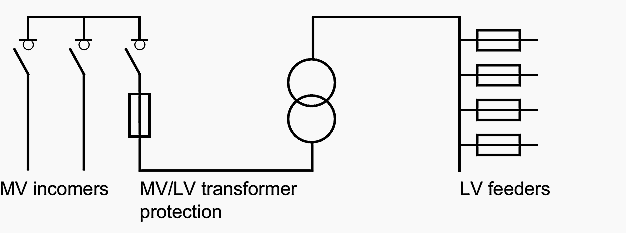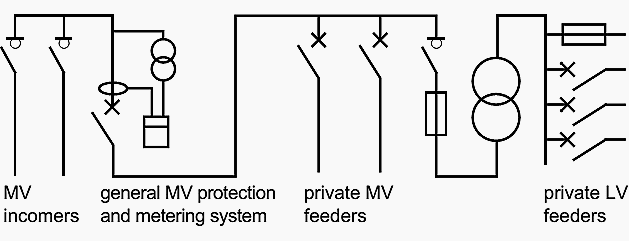Substations in public distribution systems
This technical article is a reminder of the main substations installed on MV networks. It is concluded by two layouts showing their applications in real terms. A substation or installation is a physical entity defined by its position and its function within electrical networks. The role of a substation is essentially to perform the transition between two voltage levels and / or to supply the end user.

Let’s discuss now about the four public distribution systems //
- The HV/MV substation
- The MV/MV substation
- The MV/LV substation
- The delivery substation for a HV or MV customer
1. The HV/MV substation
This installation is present in any of a country’s electrical structures. It is positioned between the subtransmission network and the MV network.
Its function is to ensure transition from HV (≈100 kV) to MV (≈10 kV). Its typical layout (see figure 1) involves two HV inputs, two transformers HV/MV, and 10 to 20 MV feeders. These feeders supply overhead lines and / or underground cables.


Go back to public distribution systems ↑
2. The MV/MV substation
This installation performs two functions //
Function #1
To ensure the demultiplication of MV feeders downstream of HV/MV substations (see figure 2). In this case, the substation does not include a transformer. It is made up of 2 MV inputs and 8 to 12 MV feeders.
This type of substation is used in several countries like Spain, Belgium, South Africa.
Function #2
To transfer between two MV voltage levels. Such MV/MV substations do contain transformers. They are necessary in countries that use two successive voltage levels in their MV networks, for instance in Great Britain where the MV network is broken down into two levels 11 kV and 33 kV.
Their typical layout ressembles that of the HV/MV substation.


Go back to public distribution systems ↑
3. The MV/LV substation
Positioned between the MV network and the LV network, this installation performs the transfer from MV (≈10 kV) to LV (≈100 V). The typical layout of this substation is of course a lot more simple than the previous installations.
These substations are made up of four parts //
- MV equipment for connection to the upstream network,
- The MV/LV distribution transformer,
- The LV feeder board as connection to the downstream network (in LV), and
- Increasingly frequently a prefabricated outer enclosure (in metal or increasingly frequently in concrete) to enclose the previous elements.


Go back to public distribution systems ↑
4. The delivery substation for a HV or MV customer
These installations perform the transfer from public distribution to private distribution. They enable connection to the HV subtransmission network for a high-consumption customer (≈MVA) via a HV/MV substation.
The delivery substations also enable connection to the MV network of a medium-consumption customer (≈100 kVA) via a MV/LV substation.
It also depends on the distributors policy, particularly on the rates offered, since for the customer this defines the cost saving advantages of electrical energy, compared with other sources of energy like oil, gas, etc.
In practice, it is the power subscribed to by the customer that determines whether he is connected to LV or MV, with very different values from country to country.
Thus, in France a customer is supplied MV from 250 kVA whereas in Italy this threshold is nearer several tens of kVA. On the other hand in the United States where a customer can be supplied LV up to 2500 kVA.


For users supplied with HV, the layout of the substation is specifically designed.
However, if the user is supplied with MV, a standard layout may be proposed (see figure 4 above). Installation of such a substation is, however, evidently dependant on the distributor’s agreement since they may have their own specific requirements (metering, operating conditions,…).
Other MV installations //
Outside of the substations already described, other MV installations exist that are mainly positioned on overhead networks. Often single function, they are used //
- Either as protection, as in the case of fuses and reclosers, or
- For operation, as in the case of remote control switches.
Go back to public distribution systems ↑
Reference // MV public distribution networks throughout the world by Christian Puret (Schneider Electric)











It’s very much informative and nicely explained how the MV (Medium Voltage) and (Low Voltage) application.
Very informative and enlightening .Thanks You.
I’ve learned a lot from you, l would like to request to please add also the meaning of LV and MV for better understanding.
Best regards
do we get compensated for my opinion?
The questions indicate the engineers or students need to study some basics.
God bless.
PS are you related toTesla?
regards